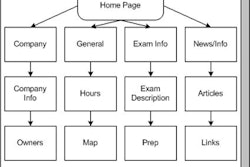For radiologists practicing in the U.S., there's no time like the present. The use of diagnostic imaging services has grown steadily over the past decade, and supply has not kept pace with demand. In a seller’s market, recruiting and retaining the ideal radiologist requires both time as well as a savvy and sophisticated strategy.
"There is a shortage of radiologists in the U.S., but it’s not the same every place you go, it’s not the same in every modality, and it’s not the same in every practice setting," said Dan Groth, CEO of Cleveland-based Locum Medical Group.
Groth, a speaker at the 2002 Radiology Business Management Association conference in Las Vegas, outlined a template of tactics that successful practices have used to acquire top professionals.
A dearth of talent
The current shortage of board-certified radiologists can be traced back to 1994, when there was a surplus of radiologists in the U.S. As a result, medical students avoided radiology residency in such numbers that by 1999, there were more jobs available in imaging services than there were radiologists to fill them.
The trend continues today, with radiology residency program inputs and outputs not meeting the demand for current or projected imaging needs. For example, George Washington University Medical School in Washington, DC, graduated 134 students from its basic medical program in June 2002. Of those 134 graduates, 5 went into radiology residency, according to Groth.
The radiologist work force of the future is also diminished by a shrinking pool of academic radiologists, whose numbers continue to decline as they are recruited into the private sector. And there are no new radiology residency programs opening up in response to market needs.
Meanwhile, the number of radiology practices in the U.S. is growing by about 6% a year. The increase is attributable not only to the growth of practices, but also to the growth of procedures and the increasing complexity of many of those procedures.
Factor in the population spike of a baby-boom demographic in the U.S. whose needs for diagnostic imaging services increases as they grow older, and the shortage of radiologists seems likely to continue for quite a while.
"Radiologists are very much aware that there’s a shortage of professional staff and are using this knowledge to leverage their positions as far as workloads are concerned, renegotiating contracts, negotiating for compensation, and the like," Groth said.
"We are seeing changes in partnership demands, from 5 years a few years ago to practically instantaneous partnership, signing bonuses to attract people to join the group, and no night and weekend call."
Recent economic hard times in the U.S. may be giving the profession some breathing room as radiologists come out of retirement in response to declines in their personal wealth. This is a short-term fix at best, Groth said. As these older radiologists reach a level of comfort with their investment portfolios, they will probably go back into retirement, which will further aggravate the shortage.
For most radiology practices, business has never been better. But the strain of meeting market demand for imaging services could make victory an uneasy one.
"From the perspective of the private practice, supply is decreasing, demand is increasing, and compensation demands are rising, but reimbursement for services is not rising to meet these demands," said Groth.
Bringing new talent on board that meshes with the culture and goals of a practice is a time-consuming process to which the group must be fully committed in order to attract the right candidates. Based on his experience, Groth said that the recruiting process in the current market is averaging 12-18 months.
Survey the marketplace
The first step in the recruiting process is for a practice to put together a recruitment committee. This group should consist of no more than three radiologists from the practice. The best participants on this committee are those who have recently been recruited to the group, Groth said.
The next step is for the recruitment committee to accurately survey the market for candidates. This can be done via the American College of Radiology’s job listing service, professional journals, and various Web sites, including AuntMinnie.com. Maintaining a liaison with program directors at residency programs can prove helpful.
Job description
The committee should put together a job description that describes how the group operates, how decisions are made, its financial history, its hospital relationships, and the features and attractions of its community. Groth recommended checking with recent recruits as to what made the group attractive to them.
The description should cover the working conditions, hours, call expectations, and workload of group members. It should also describe the equity situation in the group, such as who owns the stock, who owns the accounts receivable, what’s involved in buying into and cashing out of the practice, and any noncompete conditions the practice may wish to impose.
"These are oftentimes things that new recruits, particularly those recently out of residency, are not always tuned into. But once they get into the recruitment process, they’ll very quickly become aware of these sorts of issues. My suggestion is that you write them up and discuss them right up front," Groth said.
Compensation
"My suggestion is that when you’re looking at recruitment and retention salaries, take a look at some of the surveys that are being done by the American College of Radiology, Medical Group Management Association, AuntMinnie.com, and others will give you a pretty good idea of what’s going on in your area," he said.
On the basis of surveys that Groth and his group accumulated for 2001, the average salary for new general diagnostic radiologists (those candidates just out of residency programs) in a hospital setting runs about $245,000. Radiologists who have been practicing anywhere from 1-5 years are averaging around $267,000.
"The average bonus, which doesn’t seem to be contingent on whether the candidate is a new hire or has some experience, is around $88,000 per year, so the average is somewhere around $340,000 to $360,000 per year as a full-compensation package," he said.
Some subspecialties, such as interventional radiology, generally command a premium of $5,000-$25,000 above the average. In neuroradiology and pediatric radiology, premiums generally range from $20,000-$50,000 on top of the average, depending on need and the geographic area.
There are geographic differences, which come into play with compensation. The highest salaries are being offered in the mid-central and far west regions of the U.S. The lowest are in New England, where the salaries are considerably below the median. Overall, the differential is approximately $125,000, Groth said.
Benefits
Groth’s experience is that benefits tend to be isolated by candidates in an apples-to-apples comparison. That is, if one group offers $8,000 for CME and conference allowance, all other groups will be held to this benchmark. To avoid this, put a dollar amount on each benefit item offered by your group and total it up to offer as a complete package. This encourages the candidates to view benefits in their totality, not as isolated elements.
The benefits list should include health, disability, and life insurance; CME allowance and time off for conferences; vacation and scheduling priority and how it is determined; and any other benefits such as health club memberships or car allowances.
Recruiting
A practice can elect to recruit candidates on its own or can hire an outside agency to acquire candidates. Outside agencies are based on two types of business models: contingency or retainer.
"The predominate mode of agency business is contingency. What an agency will do for that fee varies widely. Responsibilities can range from extensive and sometimes expensive campaigns using classified advertising and direct mail to the lower end of the spectrum," Groth said. In this scenario, a firm takes the job order and looks to see if it has anyone in the databank that matches the radiologist's qualifications.
Contingency fees can vary along a broad spectrum, typically from $20,000 to $45,000, with an average fee of $25,000 to $28,000.
In the retainer model, an agency is retained for a set amount to provide a defined set of services. Each step of the search is itemized and priced in advance.
"If you connect with a hire before they reach the end of the list, that’s all the money a practice is charged. If they reach the end of the list and the practice still doesn’t have a hire, you’re out all that money and you don’t have a hire," noted Groth.
Another alternative is to involve the recruitment staff of hospitals with which the group associates. However, confidentiality can become an issue as to how much you want to divulge of the practice’s financial situation to attract a candidate through this recruiting mechanism.
A group can also elect to conduct its own recruiting search. The practice should first define its audience as either first-time hires or experienced radiologists, and then develop recruiting techniques targeted to this audience.
Recruiting pieces such as journal advertising, direct mail, postings with medical societies and professional bureaus, and Internet postings have all proven successful at one time or another. Groth recommended a telephone campaign that reaches out to other radiologists in the area to see if they know anyone who might be interested in the position.
"Oftentimes it is these radiologists who end up contacting the group in interest of their own candidacy for the position," he noted.
Dealing with responses
Groth strongly advises that the practice respond to all resumes, with both a letter of receipt and a politely worded rejection letter if the candidate does not fit the job.
"These are people that you may want to hire in the future. Professional courtesy goes a long way toward their being available for your future needs. Conversely, discourtesy will ensure that they will never be open to your solicitation," Groth said.
For qualified candidates, the firm will want to send a letter that is a general description expanded beyond what was in the job posting. More attention should be paid to the general character of the job, the group, the workload, the community, and what the practice has to offer.
Telephone interviews are the next step in the process. Script the main points the group wants to share about the practice with the candidate, and what information the group needs from the candidate to determine if they should be brought in for an onsite interview.
Once a candidate is considered for an onsite interview, the practice should arrange to get some references as well as to thoroughly verify the candidate’s educational and medical credentials.
The onsite interview
Groth emphasized the importance of a practice arranging for a candidate to bring along their spouse or significant other.
"You want to make sure fairly early on that the spouse has a pretty good sense of what’s going on with the community and with the practice. More jobs are lost as a consequence of the spouse being unhappy than with the candidate being unhappy," he noted.
When conducting the interview, one should have a good agenda worked out so that the practice appears organized and purposeful. The candidate should be introduced to the important members of the practice -- if the group is small, to everyone in the practice. Take the candidate through the job site and explain what’s going on. The spouse or significant other should be included in as much of this as the practice feels applicable.
Follow-up with the candidate, both positive and negative, should be done as quickly as possible. When people aren't a good fit, let them know as soon as possible. If they are a good fit, let them know immediately, Groth said.
Job offer
During the onsite interview process, Groth advised that practices try to identify what is important to the candidate and the candidate's family: Money, benefits, lifestyle, interesting work, call, and so on. The offer should be structured in such a way that it takes those things into consideration. Before extending a formal offer, Groth suggested testing the waters with a candidate.
"Try a test close on the candidate. For example, ‘Sheryl, if we were to put together an offer of, say, $275,000 the first year with the opportunity for a $75,000 bonus with this benefit package of x-dollars for working y-amount, would you be interested in accepting that offer if it were given to you?’ (This) gives you a real good idea of whether or not the candidate and you are in the same ballpark," he said.
Once the offer has been developed by the practice, Groth recommended putting the offer into a letter of understanding.
"There’s plenty of time to put it into a formal employment contract, but my suggestion is to use this informal method first. For example, ‘After our last conversation, this is what we felt you were looking for. Are you looking for this? If so, we’ll go ahead with a formal employment contract,’" he explained.
Contract contingencies
When constructing the formal employment contract, a practice should be sure to cover contingencies to a candidate’s employment. Standard contingencies are that the candidate will be able to get hospital privileges at institutions with whom the group works and that they will be licensed by the state medical board.
Malpractice insurance tail issues (covering malpractice issues that may arise from a former place of employment) can also be worked into the employment contract. For example, a practice will pay the tail insurance premiums if the candidate agrees to work for a set period of time.
When the offer is finalized and presented to the candidate, it’s important to give them a defined amount of time in which to review and sign the employment contract. Groth recommended that this be no longer than two weeks.
"If they can’t make a decision on their professional career in that length of time, it does not bode well for their ability to make decisions in your practice," he said.
Coming on board
First impressions are often lasting. A practice that has properly prepared for a new hire's arrival will demonstrate its committment to professionalism from the very first moment the physician shows up to work.
The recruitment committee should have a good sense of the time it takes to get a candidate’s approval from the hospitals the group works with as well as enrolled with its third-party payors -- and work this timeframe into its recruiting efforts. These payors include HMO panels, billing companies, Medicare personal identification numbers, Medicaid provider numbers, and workers compensation.
The committee should approach each agency for a specific idea of timing in its area for licensure and enrollment. Characteristically, most states see their busiest time of the year between April and September, Groth said. Also, be sure that the office space and staffing needs of the new hire are in place before their arrival.
When a start date has been set, be sure to market the new hire to the practice community. This can be accomplished via direct mail to referring physicians and hospitals, notices in the office, and newspaper advertising.
Orientation
"Be detailed, documented, and organized with every area of the practice, from transcription to billing -- this is not the time to learn as you go," Groth said.
Have a schedule set up and orientation sessions with each sub-group in the practice. This could include the technologists, billing office, admissions, transcription, information technology, satellite offices or clinics, and hospitals so that the new hire can experience the entire scope of the practice. Groth recommended taking a minimum of a few days to go over all elements of the practice with the new hire.
Integrating the new physician and their family into the community is as important as orienting them to the practice. Anchoring the family to their new home means organizing outings and other events that include members of the practice and their families.
"This practice and this community is their new home, so it’s incumbent (on you) to make it feel like home as early as possible," Groth said.
Feedback
Feedback from patients, fellow radiologists, referring physicians, and staff is important from the beginning of a new hire’s tenure
"Keeping a problem alive creates more problems. When you see that there’s a problem right up front, the best way to address it is right away," Groth said.
Feedback mechanisms should be in place. Key personnel such as the chairman of the recruiting committee or the president of the group should be available to provide input to the new hire. Groth advocated that feedback should be delivered to the new hire within the first 30 days of their employment, both positive and negative, and that new hires should have a chance to respond with their views. If there are problems, try and understand the cause of the problem and openly discuss it with the new hire, he said.
"Check in with new hire on a regular basis as to their happiness and satisfaction with the practice. Equally important, check in with their spouse on a regular basis as to their happiness and satisfaction with the community. If there are any issues, take action. Retaining a colleague is often much easier than searching for one to take their place," he said.
By Jonathan S. Batchelor
AuntMinnie.com staff writer
January 23, 2003
Related Reading
Radiologists find new recruiting incentives in tight employment market, December 12, 2002
Salary survey: U.S. radiologists make hay in southern states, June 10, 2002
Radiology job market looks rosy in coming years, October 15, 2001
Is a career in radiology right for you?, June 22, 2001
Retention, recruiting, and rewards: the three Rs of radiology staffing, February 23, 2001
Copyright © 2003 AuntMinnie.com



















